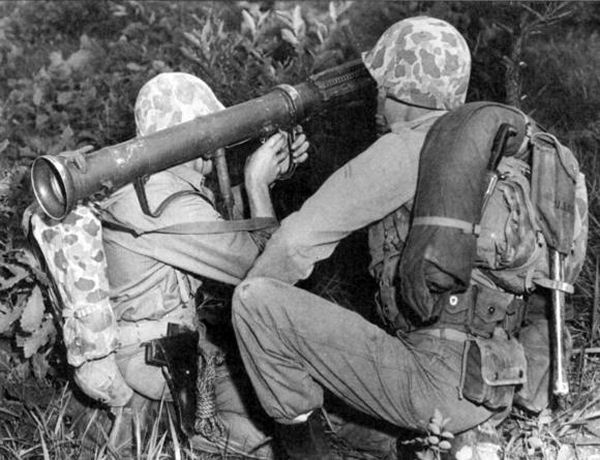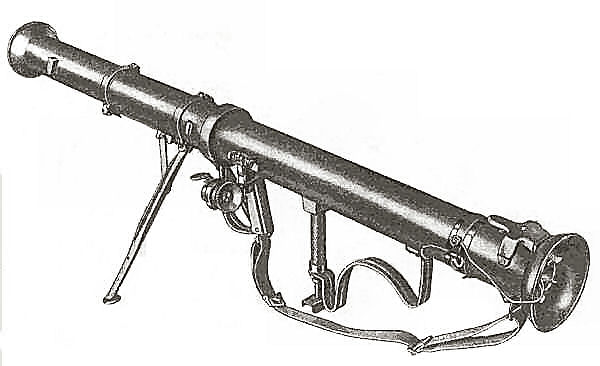The 3.5in rocket launcher M20 is a two-piece, smooth bore weapon of the open tube type, and is fired electrically. A bipod and rear support permit firing in a prone position, and the rocket may also be fired from sitting, kneeling and standing positions. The high-explosive anti-tank (HEAT) rockets are capable of penetrating heavy armour at angles of impact up to 30 degrees. Sighting on target is by means of a reflecting site mounted on the launcher. In firing, the front and rear barrel assemblies are joined to form the firing tube. While carrying, the barrels are unjoined, and fastened together side-by-side with a carrying sling, to be less cumbersome. A magneto-type firing device in the trigger grip provide the current for igniting the rockets.
The primary functions of a rocket launcher are to ignite the rocket propellant and give it initial direction in flight. Reactive forces are slight since the propulsion of the rocket is due to the jet action of the propellant powder in the motor body, and not a gas pressure built up inside the tube. Therefore, the tube needs to be only heavy enough for handling in combat, and to prevent excessive heating at normal rates of fire.
When the propellent is ignited, gases and flames are blown from the breech. The area directly at the rear must be clear of personnel or inflammable material. Because of the rear blast, the gunner must take special precautions to avoid injury when firing from the prone position.
As with the heavier German tanks, the 2.36" bazooka was not sufficiently effective against the rugged T34, arguably the best tank developed in WWII. Actually, it should never have been deployed in Korea, as the M9A1 and other 2.36" models had been withdrawn from service shortly after WWII, and nominally replaced with the M20, of similar design but with a larger rocket. The M20 was deadly against the T34.
Beginning with Vietnam the Army switched to light antitank weapons, or LAWs, such as the M72, a one-shot, disposable weapon that weighed 5 pounds fully loaded yet could launch its rocket with reasonable accuracy out to 350 yards.
Both the 2.36" and the 3.5" bazookas were deadly effective against dug-in troops, and as a short-range anti-pillbox and anti-personnel weapon, as well as against transport and tanks.
When prepared for shipment, at the factory the weapon was protected by fungus resistant coats over electrical contacts, grease films, and grease packing in the hand operated generator which ignites the propellant. On issue, grease-removing solvents were provided, to be used in readying the weapon for actual firing.
This wasn't always understood by troops in combat, especially allies unfamiliar with our approach. When Aussies were issued the 3.5 at the Battle of the Broken Bridge, October '50, they fought off a large group of NK supported by T34 tanks, but had problems igniting the propellants. When they found out about the grease --- later --- the problem ceased. Funny in retrospect, but not to a guy looking down the barrel of an 85mm cannon. Little things can make a big difference, in chaos.



